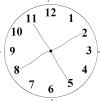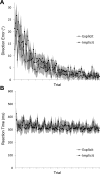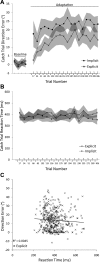A spatial explicit strategy reduces error but interferes with sensorimotor adaptation
- PMID: 21451054
- PMCID: PMC3118744
- DOI: 10.1152/jn.00002.2011
A spatial explicit strategy reduces error but interferes with sensorimotor adaptation
Abstract
Although sensorimotor adaptation is typically thought of as an implicit form of learning, it has been shown that participants who gain explicit awareness of the nature of the perturbation during adaptation exhibit more learning than those who do not. With rare exceptions, however, explicit awareness is typically polled at the end of the study. Here, we provided participants with either an explicit spatial strategy or no instructions before learning. Early in learning, explicit instructions greatly reduced movement errors but also resulted in increased trial-to-trial variability and longer reaction times. Late in adaptation, performance was indistinguishable between the explicit and implicit groups, but the mechanisms underlying performance improvements remained fundamentally different, as revealed by catch trials. The progression of implicit recalibration in the explicit group was modulated by the use of an explicit strategy: these participants showed a lower level of recalibration as well as decreased aftereffects. This phenomenon may be due to the reduced magnitude of errors made to the target during adaptation or inhibition of implicit learning mechanisms by explicit processing.
Figures






Similar articles
-
Explicit and implicit contributions to learning in a sensorimotor adaptation task.J Neurosci. 2014 Feb 19;34(8):3023-32. doi: 10.1523/JNEUROSCI.3619-13.2014. J Neurosci. 2014. PMID: 24553942 Free PMC article.
-
Eye Movements during Visuomotor Adaptation Represent Only Part of the Explicit Learning.eNeuro. 2019 Dec 23;6(6):ENEURO.0308-19.2019. doi: 10.1523/ENEURO.0308-19.2019. Print 2019 Nov/Dec. eNeuro. 2019. PMID: 31776177 Free PMC article.
-
Implicit motor learning from target error during explicit reach control.Exp Brain Res. 2010 Sep;206(1):99-104. doi: 10.1007/s00221-010-2402-4. Epub 2010 Sep 4. Exp Brain Res. 2010. PMID: 20820762
-
Human sensorimotor learning: adaptation, skill, and beyond.Curr Opin Neurobiol. 2011 Aug;21(4):636-44. doi: 10.1016/j.conb.2011.06.012. Epub 2011 Jul 20. Curr Opin Neurobiol. 2011. PMID: 21764294 Review.
-
Dual-process decomposition in human sensorimotor adaptation.Curr Opin Neurobiol. 2015 Aug;33:71-7. doi: 10.1016/j.conb.2015.03.003. Epub 2015 Mar 28. Curr Opin Neurobiol. 2015. PMID: 25827272 Review.
Cited by
-
Interleaved practice benefits implicit sequence learning and transfer.Mem Cognit. 2021 Oct;49(7):1436-1452. doi: 10.3758/s13421-021-01168-z. Epub 2021 Apr 1. Mem Cognit. 2021. PMID: 33796961 Free PMC article.
-
Effect of repeated explicit instructions on visuomotor adaptation and intermanual transfer.Exp Brain Res. 2022 Nov;240(11):2953-2963. doi: 10.1007/s00221-022-06470-z. Epub 2022 Sep 27. Exp Brain Res. 2022. PMID: 36167916 Free PMC article.
-
Eye-Hand Coordination during Visuomotor Adaptation with Different Rotation Angles: Effects of Terminal Visual Feedback.PLoS One. 2016 Nov 3;11(11):e0164602. doi: 10.1371/journal.pone.0164602. eCollection 2016. PLoS One. 2016. PMID: 27812093 Free PMC article.
-
Did I do that? Detecting a perturbation to visual feedback in a reaching task.J Vis. 2019 Jan 2;19(1):5. doi: 10.1167/19.1.5. J Vis. 2019. PMID: 30640373 Free PMC article.
-
Evidence that endpoint feedback facilitates intermanual transfer of visuomotor force learning by a cognitive strategy.J Neurophysiol. 2022 Jan 1;127(1):16-26. doi: 10.1152/jn.00008.2021. Epub 2021 Dec 8. J Neurophysiol. 2022. PMID: 34879215 Free PMC article.
References
-
- Abeele S, Bock O. Mechanisms for sensorimotor adaptation to rotated visual input. Exp Brain Res 139: 248–253, 2001 - PubMed
-
- Anguera JA, Reuter-Lorenz PA, Willingham DT, Seidler RD. Contributions of spatial working memory to visuomotor learning. J Cogn Neurosci 22: 1917–1930, 2010 - PubMed
-
- Beilock SL, Carr TH. On the fragility of skilled performance: what governs choking under pressure? J Exp Psychol Gen 130: 701–725, 2001 - PubMed
-
- Beilock SL, Carr TH, MacMahon C, Starkes JL. When paying attention becomes counterproductive: impact of divided versus skill-focused attention on novice and experienced performance of sensorimotor skills. J Exp Psychol Appl 8: 6–16, 2002 - PubMed
Publication types
MeSH terms
Grants and funding
LinkOut - more resources
Full Text Sources

